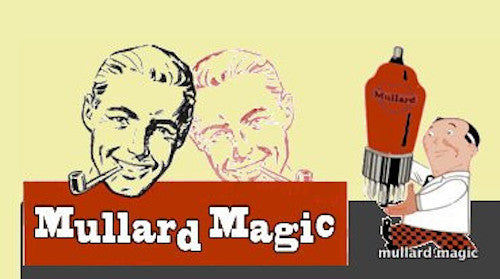
MULLARD DURING WARTIME
Share
It was a difficult time at Mullard during wartime. First of all, they were cut off from Philips - in more ways than one as the Philips and Mullard parts of the Blackburn facility were segregated with building doorways staffed by Corps of Commissionaire guards who were instructed to not let any Philips personnel into the Mullard areas. The problem was that Philips senior staff were now treated as suspect due to having family members in enemy occupied territory and were hence a coercion and security risk.
As if that wasn't enough, the jolly Germans had a crack at the Mitcham site, first of all in October 1940 when a stick of bombs hit the New Road site towards the rear of the complex which resuted in the total destruction of a machine shop. Many wags said that this was no great shakes and that Mitcham should be thankfull than the nearby marzipan factory of Renshaws was spared bombing! The next attempt was a hit purely by fluke as a V1 Flying Bomb belted a buliding again towards the rear of the complex in June 1944. The nose cone of the V1 was found in the nearby Wandle river and rescued as a trophy by a group of local children - I wonder if it still survives today?
SS Eriks decision to transfer much of valve production to Blackburn was vindicated as the Mullard Blackburn facility was never bombed, even though the first bombs hit Blackburn residential areas in August 1940. Strangely enough, Lord Haw Haw, Nazi propagandist and radio broadcaster continued to warn the people of Blackburn that the Nazis were aware of the local Royal Ordinance Factory locations and bombs would follow but Blackburn remained unharmed. It is interesting that the Nazis either didn't know about or chose to ignore the Mullard Blackburn facility.
An interesting aside is that a single V1 Flying Bomb hit Hoghton on the outskirts of Blackburn on Christmas Day 1944 - was it just off course or was it an attempt to give Mullard Blackburn a Christmas present? It's a real enigma as gyroscopic control kept all of he V1 flying bombs on their launch preset course and a turbine dynamometer situated in the nose cone of the V1 cut the fuel supply and hence stopped the pulse jet engine after a preprogrammed distance had been travelled the result being that 15 seconds later the V1 came to earth with a big kaboom. So why was Lancashire chosen - did the gyroscope wobble the V1 away from the Home Counties or was the V1 deliberately set on a Lancashire trajectory?
To put the V1 Flying bombing of Mullard facilities into perspective, the statistics are quite interesting - 2 V1 flying bombs out of the 8025 fired in total hit Mullard facilities. 1,126,998 premises other than Mullard facilities were damaged or destroyed by V1 flying bombs.

It is interesting to compare the performance of Mullard Mitcham and Blackburn during the war years, figures from 1944 show that Mitcham produced 5 million valves whereas Mullard produced 6.5 million - not bad for this six year old site! Part of this was due to the more modern production techniques ad equipment at Blackburn and part also to the larger staff quota - in 1944, Blackburn had 4185 staff on site.
Mullard valve manufacture was perceived by the government of the day as essential war work and if we compare Mullard's manufacturing to the traditional industrial mainstay of Blackburn, cotton manufacturing, some interesting facts and statistics are revealed. It's quite ironic that the latter suffered as a result of the former! Govenment policy was quite adamant that it was essential to release as many indigenous workers as possible for war production which had the effect of concentration in Blackburn (and much of Yorkshire & Lancashire) whereby many cotton mills were closed down until the number of active cotton mills in Blackburn dwindled from the peacetime level of 64 to just 19. The surviving mills found themselves engaged on the production of such unfamiliar fabrics as parachute cloth (- not very successfully as the machines were outdated and unsuitable), camouflage material, and khaki drill. The empty mills were used for storage of food supplies or strategic material as Government Storage Depots or Buffer Depots. During the "Blitz" two mills were used to rehouse firms whose premises had been bombed.
